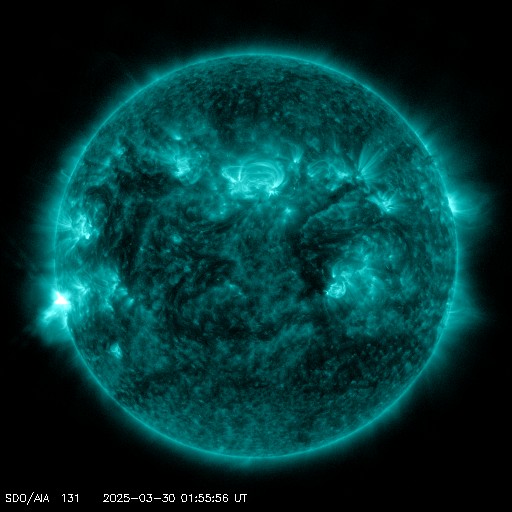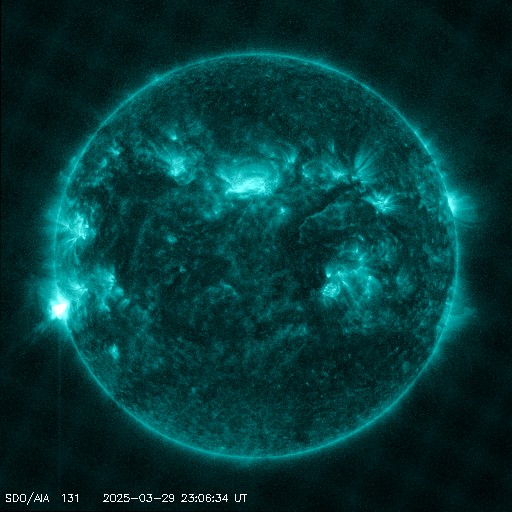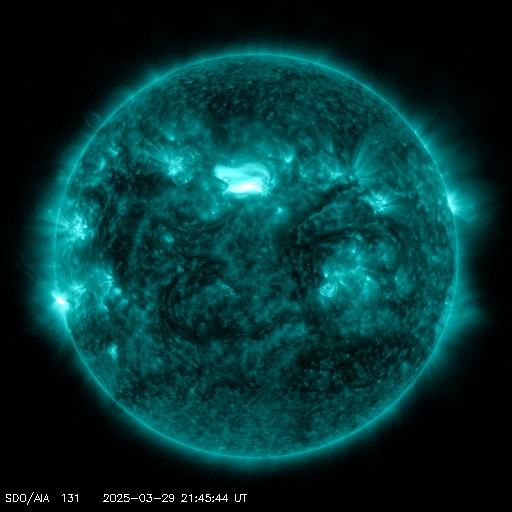Viewing archive of Saturday, 28 April 2012
Solar activity report
Any mentioned solar flare in this report has a scaling factor applied by the Space Weather Prediction Center (SWPC). Because of the SWPC scaling factor, solar flares are reported as 42% smaller than for the science quality data. The scaling factor has been removed from our archived solar flare data to reflect the true physical units.
Report of Solar-Geophysical Activity 2012 Apr 28 2200 UTCPrepared by the NOAA © SWPC and processed by SpaceWeatherLive.com
Joint USAF/NOAA Report of Solar and Geophysical Activity
SDF Number 119 Issued at 2200Z on 28 Apr 2012IA. Analysis of Solar Active Regions and Activity from 27-2100Z to 28-2100Z
Solar activity was at low levels due to single,
low-level C-class events from Regions 1461 (N10W89), 1466 (N12W51),
1467 (N12E18), 1469 (S19E14) and new Region 1470 (S17E61). New
Region 1471 (S23E70) was also numbered during the period. A 16
degree filament eruption was observed in SDO/AIA 304 imagery at
28/1045Z. During the period of the eruption, the SE to NW oriented
filament was centered near S32W33. LASCO/C2 imagery observed an
associated slow-moving, non-Earth directed CME lifting off the SW
limb at 28/1224Z.
IB. Solar Activity Forecast
Solar activity is expected to be low
with a slight chance for M-class activity for the next three days
(29 April - 01 May).
IIA. Geophysical Activity Summary 27-2100Z to 28-2100Z
The geomagnetic field was at quiet to unsettled levels with an
isolated high latitude active period between 28/0900 - 1200Z.
Through the period, ACE solar wind velocities steadily decreased
from about 490 km/s to near 420km/s while the Bz component of the
interplanetary magnetic field was variable between +/-4 nT. The
greater than 2 MeV electron flux at geosynchronous orbit was at high
levels throughout the period.
IIB. Geophysical Activity Forecast
The geomagnetic field is
expected to be at predominately quiet levels for days one and two
(29 - 30 April). By day three (01 May), quiet to unsettled levels,
with isolated active periods, are expected as a coronal hole high
speed stream moves into a geoeffective position.
III. Event Probabilities 29 Apr to 01 May
| Class M | 20% | 20% | 20% |
| Class X | 01% | 01% | 01% |
| Proton | 01% | 01% | 01% |
| PCAF | green | ||
IV. Penticton 10.7 cm Flux
Observed 28 Apr 121 Predicted 29 Apr-01 May 125/120/120 90 Day Mean 28 Apr 112
V. Geomagnetic A Indices
Observed Afr/Ap 27 Apr 007/008 Estimated Afr/Ap 28 Apr 005/005 Predicted Afr/Ap 29 Apr-01 May 004/005-004/005-007/008
VI. Geomagnetic Activity Probabilities 29 Apr to 01 May
| A. Middle Latitudes | |||
|---|---|---|---|
| Active | 10% | 10% | 15% |
| Minor storm | 01% | 01% | 05% |
| Major-severe storm | 01% | 01% | 01% |
| B. High Latitudes | |||
|---|---|---|---|
| Active | 10% | 10% | 20% |
| Minor storm | 01% | 01% | 05% |
| Major-severe storm | 01% | 01% | 01% |
All times in UTC
Current data suggests there is a slight possibility for aurora to appear at the following high latitude regions in the near future
Yellowknife, NTFairbanks, AK
Latest news
Latest forum messages
More topicsSupport SpaceWeatherLive.com!
A lot of people come to SpaceWeatherLive to follow the Sun's activity or if there is aurora to be seen, but with more traffic comes higher server costs. Consider a donation if you enjoy SpaceWeatherLive so we can keep the website online!

Latest alerts
02:09 UTC - Solar flare
Moderate M1.54 flare from sunspot region 4048
01:42 UTC - Radio Blackout
Minor R1 radio blackout in progress (≥M1 - current: M1.24)
Saturday, 29 March 2025
23:21 UTC - Solar flare
Moderate M1.91 flare from sunspot region 4048
22:51 UTC - Radio Blackout
Minor R1 radio blackout in progress (≥M1 - current: M1.1)
21:57 UTC - Solar flare
Moderate M1.45 flare from sunspot region 4048
Space weather facts
| Last X-flare | 2025/03/28 | X1.1 |
| Last M-flare | 2025/03/30 | M1.5 |
| Last geomagnetic storm | 2025/03/27 | Kp5 (G1) |
| Spotless days | |
|---|---|
| Last spotless day | 2022/06/08 |
| Monthly mean Sunspot Number | |
|---|---|
| February 2025 | 154.6 +17.6 |
| March 2025 | 127.5 -27.1 |
| Last 30 days | 127.5 -24.7 |





